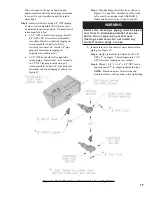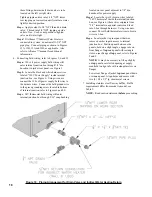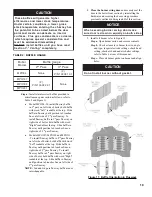
26
A. CHIMNEY VENTING
1. Chimney venting is an important part of a safe
and effi cient oil fi red appliance system. Contact
your local fi re and building offi cials on specifi c
requirements for restrictions and the installation
of fuel oil burning equipment. In addition,
consult with a professional knowledgeable on
the requirements of NFPA 31 – Standard for the
Installation of Oil-Burning Equipment and NFPA
211 - Standard for Chimneys, Fireplaces, Vents, and
Solid Fuel-Burning Appliances for installations in
the United States. Installations in Canada must be
reviewed with a professional knowledgeable on the
requirements of CSA B139-04 – Installation Code
for Oil-burning Equipment.
2. The safe venting of oil fi red boilers is dependant on
many factors. Some of these factors include:
a. suffi cient draft during the entire heating season
to allow for the safe discharge of combustion by-
products and;
b. suitable corrosion protection in the event of
condensing fl ue gases. Only a trained and
qualifi ed contractor may install this product.
3. The MPO can be vented into a fi reclay tile-lined
masonry chimney that meets requirements outlined
in Paragraph 4 below. It can also be vented into
a chimney constructed from type L vent or a
factory built chimney that complies with the type
HT requirements of UL 103. The chimney and
vent pipe shall have a suffi cient draft at all times,
to assure safe proper operation of the boiler. See
Figure 16 for recommended installation.
G
N
I
N
R
A
W
e
r
i
f
o
t
e
r
u
l
i
a
F
.
e
c
n
a
i
l
p
p
a
e
h
t
e
t
a
r
-
e
d
t
o
n
o
D
e
s
u
a
c
y
a
m
t
u
p
n
i
d
e
n
g
i
s
e
d
s
'
t
i
t
a
t
i
n
u
e
h
t
r
o
i
r
e
t
n
i
e
h
t
n
o
p
u
n
o
i
t
a
s
n
e
d
n
o
c
e
v
i
s
s
e
c
x
e
r
e
w
o
l
e
h
t
,
n
o
i
t
i
d
d
a
n
I
.
y
e
n
m
i
h
c
e
h
t
f
o
s
l
l
a
w
o
t
t
f
a
r
d
h
g
u
o
n
e
e
t
a
e
r
c
t
o
n
y
a
m
t
u
p
n
i
f
o
s
t
c
u
d
o
r
p
-
y
b
e
h
t
e
t
a
u
c
a
v
e
y
l
e
t
a
u
q
e
d
a
.
n
o
i
t
s
u
b
m
o
c
4.
Chimney Inspection – Prior to the installation of
any new or replacement fuel burning equipment the
chimney shall be inspected by a qualifi ed installer.
The chimney shall be inspected for integrity as
well as for proper draft and condensate control.
Some jurisdictions require the use of a liner when
changing fuel types. Some jurisdictions require
the use of a liner even when the same fuel is used.
At a minimum, the chimney shall be examined
by a qualifi ed person in accordance with the
requirements of Chapter 11 of NFPA 211, Standard
for Chimneys, Fireplaces, Vents, and Solid Fuel-
Burning Appliances.
SECTION V: VENTING
a. Loose Mortar – Loose mortar could be an
indication of a prior history of condensing fl ue
gases upon the inside walls of the chimney.
Colder climates are more susceptible to this
condition. Under no circumstances shall a
chimney of this condition be used until it meets
the requirements of NFPA 211 or CSA B139-
04.
b. Unlined Chimney – Under no circumstances
shall a chimney constructed of brick only
be used. Only approved clay liners or listed
chimney lining systems shall be used as specifi ed
in NFPA 31 or CSA B139-04.
c. Abandoned Openings – Openings through the
chimney wall that are no longer used shall
be sealed in accordance to NFPA 211. Often
abandoned openings are improperly sealed and
usually covered by a gypsum wall covering.
d. Clean Chimney – Chimney shall be free of all
loose debris.
5. Draft Regulator – the draft regulator supplied with
the boiler must be used with this appliance. No
other draft regulator shall be used. Refer to Figures
16 and 17.
B. CHIMNEY CONNECTOR
1. A chimney connector (vent pipe) is used to connect
the boiler to the base of the chimney. The chimney
connector should be kept as short as possible. The
horizontal length of the chimney connector shall not
be greater than 10 feet.
NOTE: Secure chimney connector to cast iron
smokebox collar with three (3) #10 x ½" self drilling
hex head TEK screws provided in miscellaneous
parts carton. Locate screws around perimeter of
connector as shown in Figure 16 and approximately
½" in from edge. Use drill with 5/16" hex bit to
drive screws through connector and smokebox
collar.
R
E
G
N
A
D
e
b
l
l
a
h
s
r
o
t
c
e
n
n
o
c
d
n
a
y
e
n
m
i
h
c
e
h
T
d
n
a
s
i
r
b
e
d
f
o
s
n
g
i
s
r
o
f
y
l
l
a
u
n
n
a
d
e
t
c
e
p
s
n
i
e
h
t
f
o
e
s
a
b
e
h
t
t
a
r
a
t
r
o
m
e
s
o
o
L
.
n
o
i
s
o
r
r
o
c
e
t
a
s
n
e
d
n
o
c
f
o
n
g
i
s
a
e
b
y
a
m
y
e
n
m
i
h
c
y
e
n
m
i
h
c
A
.
y
e
n
m
i
h
c
e
h
t
o
t
e
g
a
m
a
d
y
l
e
t
a
i
d
e
m
m
i
d
e
t
c
a
t
n
o
c
e
b
l
l
a
h
s
l
a
n
o
i
s
s
e
f
o
r
p
a
d
n
e
m
m
o
c
e
r
d
n
a
e
g
a
m
a
d
e
h
t
e
n
i
m
a
x
e
o
t
s
i
h
t
n
i
e
l
i
h
w
n
o
i
t
a
r
e
p
o
m
r
e
t
g
n
o
L
.
n
o
i
t
u
l
o
s
d
n
a
e
r
u
l
i
a
f
g
n
i
t
n
e
v
a
e
s
u
a
c
y
a
m
n
o
i
t
i
d
n
o
c
e
h
t
f
I
.
e
c
a
p
s
g
n
i
v
i
l
e
h
t
o
t
n
i
s
e
s
a
g
e
u
l
f
e
c
r
o
f
e
h
t
e
s
u
d
e
n
i
l
-
e
r
e
b
o
t
s
i
y
e
n
m
i
h
c
E
x
i
d
n
e
p
p
A
,
1
3
A
P
F
N
n
i
s
n
o
i
t
a
d
n
e
m
m
o
c
e
r
.
4
0
-
9
3
1
B
A
S
C
r
o
Summary of Contents for MPO Series
Page 6: ...6 Figure 1 MPO 84 Thru MPO 231 Water Boiler ...
Page 22: ...22 Figure 13A Water Boiler Piping for Circulator Zoned Heating System Supply Side Circulator ...
Page 38: ...38 Figure 27 L1 L2 and V1 Head Electrode Positioning and Gun Setting Beckett AFG ...
Page 49: ...49 SERVICE RECORD DATE SERVICE PERFORMED ...
Page 50: ...50 Bare Boiler Assembly ...
Page 52: ...52 Bare Boiler Assembly ...
Page 54: ...54 Jacket Assembly ...
Page 56: ...56 MPO84 Thru MPO231 Water Boilers Trim and Controls ...
Page 58: ...58 Beckett AFG Burner ...
Page 61: ...61 Figure A2 LWCO Location ...
















































